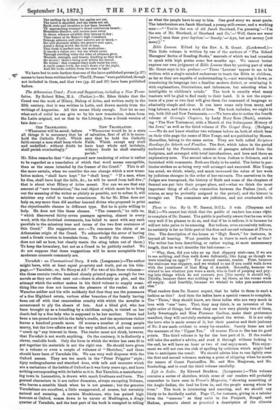Three to One. By G. W. Dasent, D.C.L. 3 vols.
(Chapman and Hall.)—We cannot but think that the public of readers has some ritht
to complain of Dr. Dasent. The public is perfectly aware that he can write very well if he pleases to do so, and that if he is tedious, it is because he
will not take pains to be amusing. But tedious, even excessively tedious, he certainly is for no little part of the first and second volumes of Three to One. The description of the house at "High Beech," for instance, is beyond all bearing. What possible fun is there in such stuff as this? The writer has been describing, or rather saying, at most unnecessary length, that he won't describe the bed-rooms:—
" Why, then, did you take us up that slippery stair-ease, if we are to see nothing, and then walk down delicately, like A.gag, as though we
were treading on eggs ? ' For several reasons, reader. First, because the staircase was slippery, and we wished to see if you could walk down with the jauntiness of that Sing of Amalek. Secondly, because we wished to see whether you were a snob, who is fond of peeping and pry- ing into things which do not concern you [him surely it should be]. Thirdly, because there was nothing to see up there, as the rooms were else."
What And fourthly, because we wished to take you somewhere
What readers does Dr. Defiant expect, that he talks to them in snob a
fashion as this? And then the ladies have a special reason to complain.
The "Three," they should know, are three ladies who are very much in love with "one" hero. That, they may think, is an inversion of the right order of things, but when they see how very plainly two of them, Lady Sweetapple and Miss Florence Carlton, make their preference manifest, they will certainly exclaim against the writer. It is not only the hero who is made aware of it, but their passion and their jealousy
of No. 3 are made evident to every by-stander. Surely these are not the manners of the "Upper Ten." Of coarse Three to One has its good
points. The third volume is by far the best part of it. If the reader will take the author's advice, and read it through without looking to the end, he will have an hour or two of real enjoyment. This enjoy- meat we will not run the risk of spoiling by criticism which might lead him to anticipate the result. We should advise him to run lightly over the first and second volumes, making a point of skipping when he meets the names of Count Pantouffies, Mr. and Mrs. Marjoram, and Mr. Sonderling, and to read the third volume carefully.


































 Previous page
Previous page